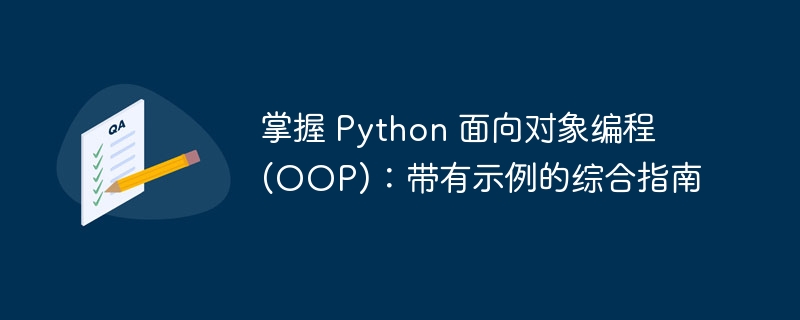掌握 Python 面向对象编程 (OOP):带有示例的综合指南
来源:dev.to
时间:2024-11-17 14:42:51 170浏览 收藏
知识点掌握了,还需要不断练习才能熟练运用。下面golang学习网给大家带来一个文章开发实战,手把手教大家学习《掌握 Python 面向对象编程 (OOP):带有示例的综合指南》,在实现功能的过程中也带大家重新温习相关知识点,温故而知新,回头看看说不定又有不一样的感悟!

介绍
面向对象编程(oop)是现代软件开发中最流行的编程范例之一。它允许您使用类和对象对现实世界的实体进行建模,使代码可重用、模块化和可扩展。在这篇博文中,我们将使用单个用例示例从基础到高级探索 python 的 oop 概念:为在线商店构建库存管理系统。
为什么使用面向对象编程?
- 模块化:代码被分解为独立的模块。
- 可重用性:一旦编写了一个类,您就可以在程序或未来项目中的任何地方使用它。
- 可扩展性:oop 允许程序通过添加新类或扩展现有类来扩展。
- 可维护性:更易于管理、调试和扩展。
基本概念:类和对象
什么是类和对象?
- class:创建对象(实例)的蓝图。它定义了对象将具有的一组属性(数据)和方法(函数)。
- object:类的实例。您可以将对象视为具有状态和行为的现实世界实体。
示例:库存项目类别
让我们首先创建一个类来表示我们在线商店库存中的商品。每件商品都有名称、价格和数量。
class inventoryitem:
def __init__(self, name, price, quantity):
self.name = name
self.price = price
self.quantity = quantity
def get_total_price(self):
return self.price * self.quantity
# creating objects of the class
item1 = inventoryitem("laptop", 1000, 5)
item2 = inventoryitem("smartphone", 500, 10)
# accessing attributes and methods
print(f"item: {item1.name}, total price: ${item1.get_total_price()}")
说明:
- __init__方法是构造函数,用于初始化对象的属性。
- self 指的是类的当前实例,允许每个对象保持自己的状态。
- 方法 get_total_price() 根据商品的价格和数量计算总价。
封装:控制对数据的访问
什么是封装?
封装限制对对象属性的直接访问,以防止意外修改。相反,您通过方法与对象的数据进行交互。
示例:使用 getter 和 setter
我们可以通过将属性设置为私有并使用 getter 和 setter 方法控制访问来改进 inventoryitem 类。
class inventoryitem:
def __init__(self, name, price, quantity):
self.__name = name # private attribute
self.__price = price
self.__quantity = quantity
def get_total_price(self):
return self.__price * self.__quantity
# getter methods
def get_name(self):
return self.__name
def get_price(self):
return self.__price
def get_quantity(self):
return self.__quantity
# setter methods
def set_price(self, new_price):
if new_price > 0:
self.__price = new_price
def set_quantity(self, new_quantity):
if new_quantity >= 0:
self.__quantity = new_quantity
# example usage
item = inventoryitem("tablet", 300, 20)
item.set_price(350) # update price using the setter method
print(f"updated price of {item.get_name()}: ${item.get_price()}")
说明:
- 属性现在是私有的(__name、__price、__quantity)。
- 您可以使用 getter 和 setter 方法访问或修改这些属性,从而保护对象的内部状态。
继承:在新类中重用代码
什么是继承?
继承允许一个类(子类)从另一个类(父类)继承属性和方法。这促进了代码的可重用性和层次结构建模。
示例:扩展库存系统
让我们扩展我们的系统来处理不同类型的库存物品,例如 perishableitem 和 nonperishableitem。
class inventoryitem:
def __init__(self, name, price, quantity):
self.__name = name
self.__price = price
self.__quantity = quantity
def get_total_price(self):
return self.__price * self.__quantity
def get_name(self):
return self.__name
class perishableitem(inventoryitem):
def __init__(self, name, price, quantity, expiration_date):
super().__init__(name, price, quantity)
self.__expiration_date = expiration_date
def get_expiration_date(self):
return self.__expiration_date
class nonperishableitem(inventoryitem):
def __init__(self, name, price, quantity):
super().__init__(name, price, quantity)
# example usage
milk = perishableitem("milk", 2, 30, "2024-09-30")
laptop = nonperishableitem("laptop", 1000, 10)
print(f"{milk.get_name()} expires on {milk.get_expiration_date()}")
print(f"{laptop.get_name()} costs ${laptop.get_total_price()}")
说明:
- perishableitem 和 nonperishableitem 继承自 inventoryitem。
- super()函数用于调用父类的构造函数(__init__)来初始化公共属性。
- perishableitem 添加了新属性expiration_date。
多态性:可互换的对象
什么是多态性?
多态性允许不同类的对象被视为公共超类的实例。它使您能够在父类中定义在子类中重写的方法,但您可以在不知道确切的类的情况下调用它们。
示例:多态行为
让我们修改我们的系统,以便我们可以根据项目类型显示不同的信息。
class inventoryitem:
def __init__(self, name, price, quantity):
self.__name = name
self.__price = price
self.__quantity = quantity
def display_info(self):
return f"item: {self.__name}, total price: ${self.get_total_price()}"
def get_total_price(self):
return self.__price * self.__quantity
class perishableitem(inventoryitem):
def __init__(self, name, price, quantity, expiration_date):
super().__init__(name, price, quantity)
self.__expiration_date = expiration_date
def display_info(self):
return f"perishable item: {self.get_name()}, expires on: {self.__expiration_date}"
class nonperishableitem(inventoryitem):
def display_info(self):
return f"non-perishable item: {self.get_name()}, price: ${self.get_total_price()}"
# example usage
items = [
perishableitem("milk", 2, 30, "2024-09-30"),
nonperishableitem("laptop", 1000, 10)
]
for item in items:
print(item.display_info()) # polymorphic method call
说明:
- perishableitem 和 nonperishableitem 中均重写了 display_info() 方法。
- 当您对对象调用 display_info() 时,python 会根据对象的类型使用适当的方法,即使特定类型在运行时未知。
高级概念:装饰器和类方法
类方法和静态方法
- 类方法是属于类本身的方法,而不是属于任何对象的方法。它们标有@classmethod。
- 静态方法不访问或修改类或实例特定的数据。它们被标记为@staticmethod。
示例:使用类方法管理库存
让我们添加一个类级别的方法来跟踪库存中的商品总数。
class inventoryitem:
total_items = 0 # class attribute to keep track of all items
def __init__(self, name, price, quantity):
self.__name = name
self.__price = price
self.__quantity = quantity
inventoryitem.total_items += quantity # update total items
@classmethod
def get_total_items(cls):
return cls.total_items
# example usage
item1 = inventoryitem("laptop", 1000, 5)
item2 = inventoryitem("smartphone", 500, 10)
print(f"total items in inventory: {inventoryitem.get_total_items()}")
说明:
- total_items 是所有实例共享的类属性。
- 类方法 get_total_items() 允许我们访问此共享数据。
oop 中的装饰器
oop 中的装饰器通常用于修改方法的行为。例如,我们可以创建一个装饰器来自动记录库存系统中的方法调用。
def log_method_call(func):
def wrapper(*args, **kwargs):
print(f"Calling method {func.__name__}")
return func(*args, **kwargs)
return wrapper
class InventoryItem:
def __init__(self, name, price, quantity):
self.__name = name
self.__price = price
self.__quantity = quantity
@log_method_call
def get_total_price(self):
return self.__price * self.__quantity
# Example usage
item = InventoryItem("Tablet", 300, 10)
print(item.get
_total_price()) # Logs the method call
结论
python 中的面向对象编程提供了一种强大而灵活的方式来组织和构建代码。通过使用类、继承、封装和多态性,您可以对复杂系统进行建模并增强代码的可重用性。在这篇文章中,我们介绍了关键的 oop 概念,逐步构建一个库存管理系统来演示每个原则。
python 中的 oop 使您的代码更具可读性、可维护性,并且随着应用程序复杂性的增长而更易于扩展。快乐编码!
本篇关于《掌握 Python 面向对象编程 (OOP):带有示例的综合指南》的介绍就到此结束啦,但是学无止境,想要了解学习更多关于文章的相关知识,请关注golang学习网公众号!
-
501 收藏
-
501 收藏
-
501 收藏
-
501 收藏
-
501 收藏
-
281 收藏
-
305 收藏
-
443 收藏
-
237 收藏
-
187 收藏
-
196 收藏
-
120 收藏
-
161 收藏
-
353 收藏
-
312 收藏
-
218 收藏
-
447 收藏
-

- 前端进阶之JavaScript设计模式
- 设计模式是开发人员在软件开发过程中面临一般问题时的解决方案,代表了最佳的实践。本课程的主打内容包括JS常见设计模式以及具体应用场景,打造一站式知识长龙服务,适合有JS基础的同学学习。
- 立即学习 543次学习
-

- GO语言核心编程课程
- 本课程采用真实案例,全面具体可落地,从理论到实践,一步一步将GO核心编程技术、编程思想、底层实现融会贯通,使学习者贴近时代脉搏,做IT互联网时代的弄潮儿。
- 立即学习 516次学习
-

- 简单聊聊mysql8与网络通信
- 如有问题加微信:Le-studyg;在课程中,我们将首先介绍MySQL8的新特性,包括性能优化、安全增强、新数据类型等,帮助学生快速熟悉MySQL8的最新功能。接着,我们将深入解析MySQL的网络通信机制,包括协议、连接管理、数据传输等,让
- 立即学习 500次学习
-

- JavaScript正则表达式基础与实战
- 在任何一门编程语言中,正则表达式,都是一项重要的知识,它提供了高效的字符串匹配与捕获机制,可以极大的简化程序设计。
- 立即学习 487次学习
-

- 从零制作响应式网站—Grid布局
- 本系列教程将展示从零制作一个假想的网络科技公司官网,分为导航,轮播,关于我们,成功案例,服务流程,团队介绍,数据部分,公司动态,底部信息等内容区块。网站整体采用CSSGrid布局,支持响应式,有流畅过渡和展现动画。
- 立即学习 485次学习
